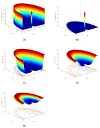A mathematical model for foreign body reactions in 2D
- PMID: 21532988
- PMCID: PMC3084539
- DOI: 10.1080/00207161003640035
A mathematical model for foreign body reactions in 2D
Abstract
The foreign body reactions are commonly referred to the network of immune and inflammatory reactions of human or animals to foreign objects placed in tissues. They are basic biological processes, and are also highly relevant to bioengineering applications in implants, as fibrotic tissue formations surrounding medical implants have been found to substantially reduce the effectiveness of devices. Despite of intensive research on determining the mechanisms governing such complex responses, few mechanistic mathematical models have been developed to study such foreign body reactions. This study focuses on a kinetics-based predictive tool in order to analyze outcomes of multiple interactive complex reactions of various cells/proteins and biochemical processes and to understand transient behavior during the entire period (up to several months). A computational model in two spatial dimensions is constructed to investigate the time dynamics as well as spatial variation of foreign body reaction kinetics. The simulation results have been consistent with experimental data and the model can facilitate quantitative insights for study of foreign body reaction process in general.
Figures
















Similar articles
-
A Predictive Tool for Foreign Body Fibrotic Reactions Using 2-Dimensional Computational Model.Open Access Bioinformatics. 2011 Jan 1;2011(3):19-35. doi: 10.2147/OAB.S14254. Open Access Bioinformatics. 2011. PMID: 21836814 Free PMC article.
-
A computational model of fibroblast and macrophage spatial/temporal dynamics in foreign body reactions.J Immunol Methods. 2013 Nov 29;397(1-2):37-46. doi: 10.1016/j.jim.2013.08.013. Epub 2013 Aug 31. J Immunol Methods. 2013. PMID: 24001881 Free PMC article.
-
Stability analysis of a model for foreign body fibrotic reactions.Comput Math Methods Med. 2012;2012:809864. doi: 10.1155/2012/809864. Epub 2012 Sep 13. Comput Math Methods Med. 2012. PMID: 23193430 Free PMC article.
-
The foreign body response: at the interface of surgery and bioengineering.Plast Reconstr Surg. 2015 May;135(5):1489-1498. doi: 10.1097/PRS.0000000000001193. Plast Reconstr Surg. 2015. PMID: 25919260 Review.
-
Translational Metabolomics of Head Injury: Exploring Dysfunctional Cerebral Metabolism with Ex Vivo NMR Spectroscopy-Based Metabolite Quantification.In: Kobeissy FH, editor. Brain Neurotrauma: Molecular, Neuropsychological, and Rehabilitation Aspects. Boca Raton (FL): CRC Press/Taylor & Francis; 2015. Chapter 25. In: Kobeissy FH, editor. Brain Neurotrauma: Molecular, Neuropsychological, and Rehabilitation Aspects. Boca Raton (FL): CRC Press/Taylor & Francis; 2015. Chapter 25. PMID: 26269925 Free Books & Documents. Review.
Cited by
-
A Predictive Tool for Foreign Body Fibrotic Reactions Using 2-Dimensional Computational Model.Open Access Bioinformatics. 2011 Jan 1;2011(3):19-35. doi: 10.2147/OAB.S14254. Open Access Bioinformatics. 2011. PMID: 21836814 Free PMC article.
-
Models for Implant-Induced Capsular Contracture Post Breast Cancer Surgery.Bull Math Biol. 2023 Dec 13;86(1):7. doi: 10.1007/s11538-023-01236-2. Bull Math Biol. 2023. PMID: 38091110 Free PMC article.
-
A computational model of fibroblast and macrophage spatial/temporal dynamics in foreign body reactions.J Immunol Methods. 2013 Nov 29;397(1-2):37-46. doi: 10.1016/j.jim.2013.08.013. Epub 2013 Aug 31. J Immunol Methods. 2013. PMID: 24001881 Free PMC article.
-
Interaction of Ceramic Implant Materials with Immune System.Int J Mol Sci. 2023 Feb 20;24(4):4200. doi: 10.3390/ijms24044200. Int J Mol Sci. 2023. PMID: 36835610 Free PMC article. Review.
-
Computational modeling of phagocyte transmigration for foreign body responses to subcutaneous biomaterial implants in mice.BMC Bioinformatics. 2016 Feb 29;17:111. doi: 10.1186/s12859-016-0947-3. BMC Bioinformatics. 2016. PMID: 26927968 Free PMC article.
References
-
- Dee KC, Puleo DA, Bizios R. An introduction to tissue-biomaterial interactions. Hoboken, John Wiley & Sons Inc; New Jersey: 2002. Wound healing; pp. 165–214.
-
- Anderson JM. Inflammation and the foreign body response. Prob Gen Surgery. 1994;11:147–160.
-
- Tang L, Eaton JW. Inflammatory responses to biomaterials. Am J Clin Path. 1995;103:466–71. - PubMed
-
- McDonald JA. Fibronectin: a primitive matrix. In: Clark RAF, Henson PM, editors. The molecular and cellular biology of wound repair. Plenum Press; New York: 1988. pp. 405–436.
-
- Appling WD, O’Brien WR, Johnston DA, Duvie M. Synergistic enhancement of type I and III collage production in cultured fibroblast by transforming growth factor - β and ascorbate. FEBS letter. 1989;250:541–544. - PubMed
Grants and funding
LinkOut - more resources
Full Text Sources
